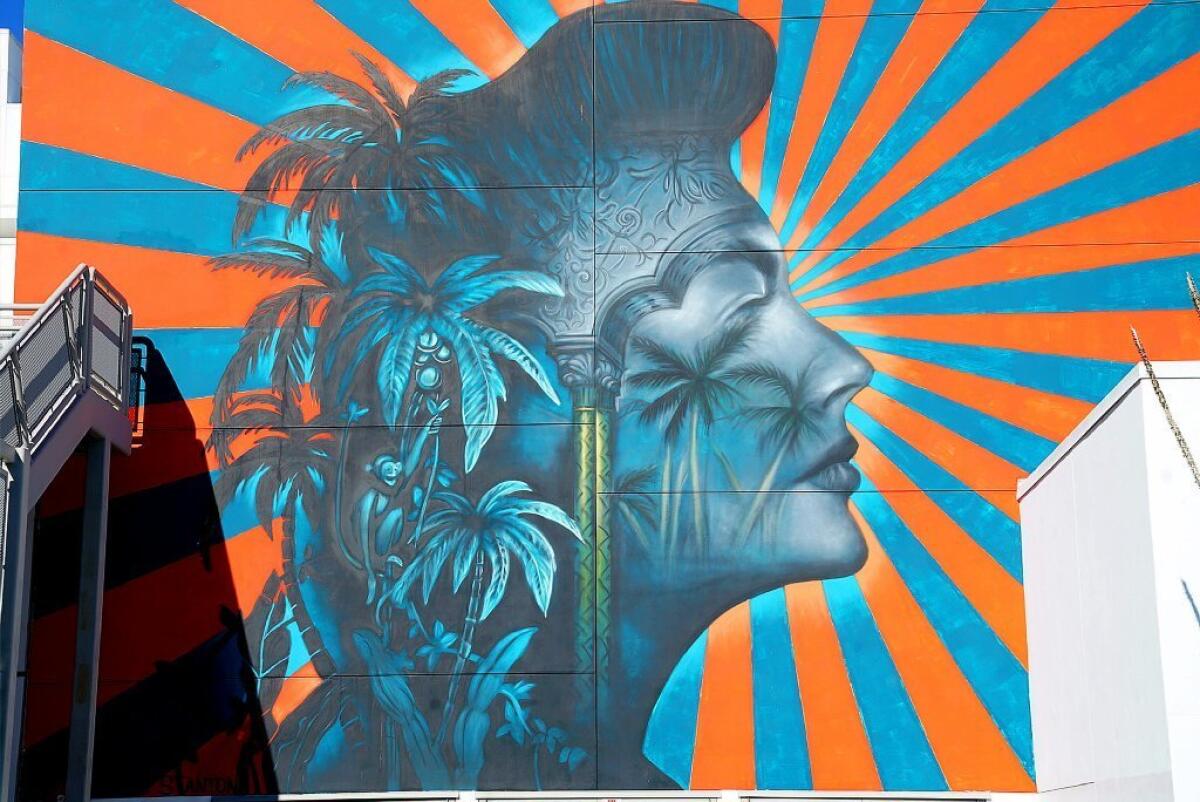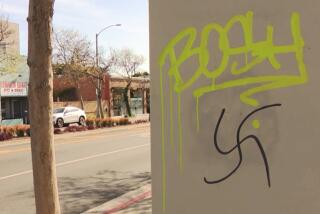LAUSD mural debate reignites as Korean American coalition launches new campaign

The debate over a school mural in Koreatown has pitted community members who called the work racist against anti-censorship artists and free-speech advocates. Now a new and surprising voice has entered the fray: a coalition of artists, curators and local museum staffers advocating for the mural to be removed or substantially altered.
The mural by Beau Stanton at the Robert F. Kennedy Community Schools complex depicts the face of Ava Gardner, who frequented the Cocoanut Grove nightclub that once stood on the Wilshire Boulevard site. But the orange-red and blue rays fanned out around her face, critics said, evoke the World War II-era imperial Japanese battle flag. The imagery is offensive to some Koreans and Korean Americans who live or work nearby, critics have said.
The Los Angeles Unified School District agreed in early December to erase the mural. The school district then reversed its position after fierce pushback from artists, arts advocates and others, such as the National Coalition Against Censorship, citing the importance of freedom of speech, particularly on a school campus named for the champion of social justice who was murdered at the site in 1968. LAUSD officials said they would explore potential solutions, but no action has been taken.
Now a group of art-world professionals organized under the name Gyopo (loosely meaning Korean diaspora) is resurrecting the issue and calling for the mural to be removed or substantially altered. Gyopo has sent a letter to LAUSD local district superintendent Roberto Martinez and board President Monica Garcia imploring that they take fast action and adding that silence from the school board has been troubling. The artwork, Gyopo said, distresses locals and triggers memories of atrocities committed against Koreans and others by Japanese forces during the war.
“Symbols can hold trauma and imagery can hold trauma,” artist and Gyopo member Jennifer Moon said in an interview.
Other Gyopo members include Nancy Lee, senior manager of public relations at the Hammer Museum, and Christine Y. Kim, associate curator of contemporary art at the Los Angeles County Museum of Art and co-founder of Gyopo — though both Lee and Kim emphasized they were not participating on behalf of their employers. They downplayed any potential contradiction between their roles as art professionals who defend freedom of speech and artistic expression and their personal roles advocating for cultural sensitivity in this particular case.
“We don’t want the conversation to be over just because the news coverage is over,” Lee said. “It’s been really quiet for a while, as if we’re being swept under the rug, this voiceless or small or less powerful community. We want to make sure the discussion comes back, that it’s top of mind.”
The school district said it’s close to a decision. “We appreciate the comments we have received from the community regarding the RFK mural project,” a district spokesperson said via email. “Over the past few weeks, we have been involved in a number of informative discussions. We hope to make a decision in the near future.”
In its letter, Gyopo acknowledged that Stanton didn’t purposefully evoke the Japanese battle flag or intend to upset the local community. Nonetheless, Gyopo is troubled by “the lack of community involvement in the mural’s selection process, the mural’s imagery itself and its memorialization of a whites-only club, and the ways in which the media has directed these narratives.”
The latter — how the mural debate has been framed and by whom — is of particular importance to Gyopo. Until now, the conversation has been polarized and oversimplified, Kim said, but it’s actually far more nuanced.
“It’s been framed as ‘censorship versus artistic integrity’ in the press and, I’d imagine, in certain discussions and it’s a matter of reframing with greater sensitivity,” Kim said. “It’s a framing that may grab headlines or attention, but it dismisses cultural and individual pain and trauma that’s very real that’s elicited from an artwork that’s displayed in a very public manner, in a place where there are thousands of students, young people and community members who see it every day.”

Gyopo especially takes issue with people who aren’t of Korean descent who have said the mural doesn’t resemble the battle flag or isn’t offensive, including artist Shepard Fairey and Times art critic Christopher Knight. They can’t fully understand the perspective of those offended by the work, Gyopo members said, although in a column on the subject Knight wrote that he is quite aware of the pain caused by the Imperial Japanese Army: Knight’s husband’s family in the Philippines lost its home and business when the empire attacked Manila, and one family member barely survived the notorious Bataan Death March.
“The issue,” Moon said, “is someone comes in who’s not from this history and says that’s not traumatic and people listen. And to me, that replicates a system where white men, historically, their voices are seen as authority. And historically, I think Asian voices are not heard, there’s this silence or invisibility that happens.”
Whether the mural does or doesn’t resemble the Japanese imperial flag is of secondary importance, Kim said. “The fact is that it’s upsetting and hurtful for individuals who see it.”
The letter to LAUSD officials comes from Gyopo’s 11-person steering committee and other community members and includes artist and UC Irvine professor emerita Yong Soon Min and Various Small Fires gallery owner Esther Varet Kim, who also say they’re acting as independent Angelenos, not on behalf of their arts organizations.
Other petitioners include Korea Arts Foundation of America board member Ellie Lee; Southern California Institute of Architecture faculty member Kavior Moon; artist Gala Porras-Kim; Eric Kim, co-founder of the nonprofit arts space Human Resources Los Angeles; and Kibum Kim, associate director and head of art business at Sotheby’s Institute of Art Los Angeles.
“As a contemporary art curator I’m completely supportive of diverse artistic voices and practices,” Christine Y. Kim said. “And I am not demanding that Beau Stanton’s mural be censored. As a private citizen who happens to be Korean American, however, I understand the cultural trauma and pain that this mural has elicited. It’s a very fine line to walk and a complex issue that’s important for me to consider on both levels.”
The Hammer’s Lee said she didn’t feel any tension here between the defense of artistic expression, the call for cultural sensitivity and the suggestion that the mural be removed or altered. “I think all artists would want to work with people with integrity and that’s how we think we’re behaving right now — with integrity to our community.”
Stanton said there’s no connection between his RFK work and the Japanese battle flag, which features 32 rays around a red circle whereas his RFK work has 44 rays in red-orange and blue. He has used the sun-ray motif in murals in Miami, Nashville and Jersey City, N.J., as well as in Europe. “It’s a fairly ubiquitous, universal pattern and I don’t use it in a way that’s meant to reference those painful memories,” he said.

The mural was part of a larger 2016 project in which LAUSD and the L.A. firm Branded Arts put up 28 outdoor works around the RFK community schools campus. Stanton and the other artists, including Fairey, painted the works for free. In December Fairey came to Stanton’s defense, threatening to whitewash his portrait of Robert F. Kennedy on the school library if the school district were to remove Stanton’s work.
Allison Torneros, a Filipino artist who goes by the name Hueman, and David Torres, who is of Puerto Rican-Jewish descent and half the art duo Cyrcle, were also part of the RFK mural project. Both came to Stanton’s defense.
“As a Filipino American — because Filipinos went through a similar thing with the Japanese during World War II — it’s definitely something I can relate to in terms of history and my culture,” Torneros said. “But I don’t think this is about that. It’s about censorship. If we’re just going around making rash decisions about art, because certain people are deciphering it a certain way, I think that’s irresponsible. Because anything can be misinterpreted, and then what art will we have left?”
The call to remove or alter the Stanton mural is not censorship but rather a request “to look at these systemic issues of power and for a conversation about, and an acknowledgement of, trauma,” Moon said. “It’s a more intersectional conversation: What’s the race, class, gender or sexuality of the artist, of those affected by the art, of the authoritative voice guiding the discussion?”
Gyopo suggested that Stanton could paint a new mural, or RFK students and staff could paint a replacement mural in conjunction with the community.
“If we can figure out a compromise I’m happy to hear it,” Stanton said. “But I’d emphasize that it should come from within, rather than being imposed from the outside. It should not be my choice or some outside group’s but the school stakeholders — the children, teachers, principals, administrators. I created the mural for them.”
Stanton said he’d be willing to change the red-orange stripes to yellow. The act of compromise might even be a learning experience for children, he said.
“Especially in today’s politics, no one wants to compromise because everyone’s so entrenched in their views,” he said. “And compromise here, maybe that’s a good thing.”
Compromise is “welcome and invited,” Kim said. “As is discussion.”
More to Read
The biggest entertainment stories
Get our big stories about Hollywood, film, television, music, arts, culture and more right in your inbox as soon as they publish.
You may occasionally receive promotional content from the Los Angeles Times.







